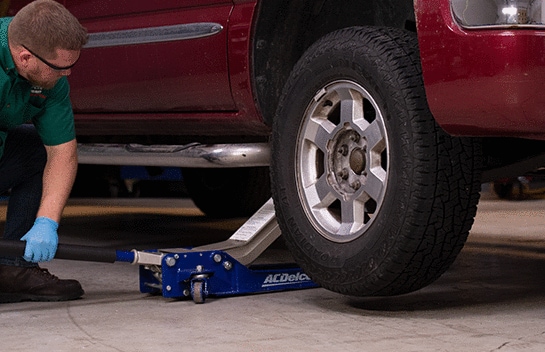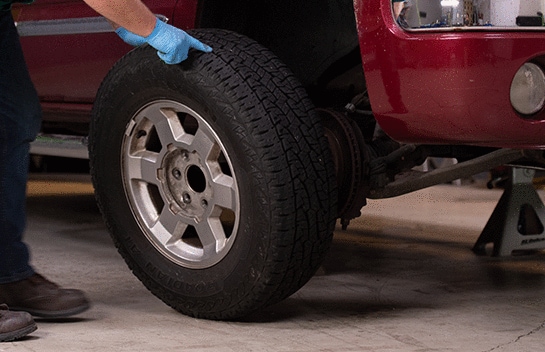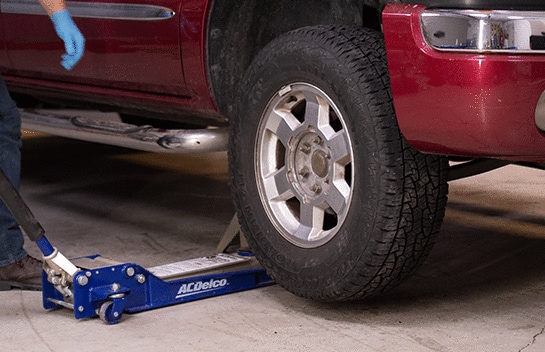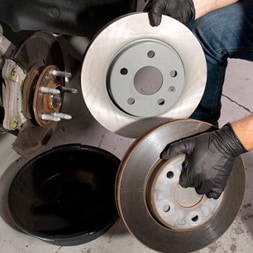Today, we will be changing the shocks on this 2003 Silverado 1500, and the procedure will be similar on a lot of early Silverados from about 99 to 07, but be sure to know the specifics for your truck before getting started. If you’re not completely comfortable doing this yourself, we’d be happy to recommend a professional technician in your area.
How to Change the Front Shocks on a 1999-2007 Chevy Silverado
Your GMC Sierra 1500 or Chevy Silverado 1500’s front shock absorbers dampen the suspension movement of your truck for a smoother ride. Replacing worn shock absorbers on your 1999-2007 GMC Sierra is a straightforward repair that can help improve your truck’s handling, tire wear, movement, braking time, and the overall ride. If your GMC Sierra 1500’s shock absorbers are failing, you may experience excessive rocking, poor handling, oil leaks near the lower shock tube or shaft seal, knocking noises, damaged rubber bushings, or longer braking time. Exposure to extremely high temperatures and other weather conditions can contribute to failing shock absorbers, and they should be replaced as soon as you suspect a problem in order to prevent tire and suspension damage to your truck. It’s recommended that you inspect or replace your shocks every 50,000 miles, and both shock absorbers on your GMC Sierra 1500 should be replaced at the same time since they have experienced the same amount of use. Our detailed, step-by-step instructions will help you perform a front shock absorber replacement on your 1999-2007 GMC Sierra 1500 or Chevy Silverado 1500.
Chevy Silverado Front Shock Replacement Tools & Materials
Chevy Silverado Front Shock Replacement Instructions
Remove the Shock Absorber

Step 1: Raise the Front of the Truck

Step 2: Remove the Wheel

Step 3: Remove the Upper Nut
Starting on one side, remove the nut at the upper end of the shock.
|
Do It Right: Applying penetrating oil will help when it comes time to loosen nuts and bolts. |

Step 4: Remove the Upper Insulator

Step 5: Remove the Mounting Bolt

Step 6: Remove the Shock Absorber
Install the New Shocks

Step 7: Set Aside the Old Shock Absorber

Step 8: Prime the Shock Absorber
Before installation, prime the shock absorber by fully compressing and letting it extend on its own 4-5 times. This will ensure that the gas and oil are in the proper position inside the shock, and can help prevent unwanted noise when you start driving with the new shocks in place.
|
Do It Right: Be sure to have the shock upright with the dust boot or metal shield at the top when priming and when installing. |

Step 9: Place the New Shock Absorber

Step 10: Install the Bolt at the Lower Control Arm

Step 11: Install the Upper Insulator
Install the upper insulator on the shock absorber and the nut on the tenon end. Don’t tighten the nut until the vehicle is lowered.
|
Do It Right: Except in unusual circumstances, it’s recommended you change shocks in pairs, so repeat these steps on the other side of the Chevy Silverado. |

Step 12: Re-install the Front Wheel

Step 13: Lower the Truck

Step 14: Secure the Tenon End
Additional Resources
These step-by-step instructions and video detail a front shock absorber replacement on a 2003 Silverado 1500, and the procedures will be the same for your 1999, 2000, 2001, 2002, 2004, 2005, 2006, and 2007 GMC Sierra 1500 and Chevy Silverado 1500. Replacing worn shock absorbers helps you maintain a safe, working suspension system, and can help you avoid an accident. If you notice oil leaks near the shock tube or shaft seal, knocking noises, excessive rocking, longer braking time, or decreased handling, it is important to replace the front shock absorbers as soon as possible.
The automotive repair work depicted in this series is performed under the direction of the manufacturer of the product featured. Prior to undertaking any of the demonstrated repairs on your vehicle, we suggest you consult with a certified mechanic or another professional who can adequately advise you of the proper repair or remedy required. O’Reilly Automotive Stores, Inc. and its affiliates (“O’Reilly”) disclaims any responsibility for injury or damage resulting from a viewer’s attempt to recreate the repairs shown in this series.

 Safety Glasses
Safety Glasses
 Nitrile Gloves
Nitrile Gloves
 21 mm Socket
21 mm Socket
 Ratchet
Ratchet
 Floor Jack
Floor Jack
 Jack Stands
Jack Stands
 Breaker Bar
Breaker Bar
 Box Wrench
Box Wrench
 Torque Wrench
Torque Wrench
 Penetrating Oil
Penetrating Oil
 Wheel Chocks
Wheel Chocks


